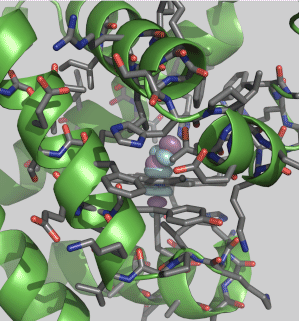Danny Cole

Dr Danny Cole
Lecturer in Computational Chemistry, Newcastle
Visitor in Prof Payne's group
TCM Group, Cavendish Laboratory
19 JJ Thomson Avenue,
Cambridge, CB3 0HE UK.

Research
I am a Marie Curie Research Fellow, hosted by the Jorgensen lab at Yale University and the Theory of Condensed Matter Group at the University of Cambridge.
Large-scale Density Functional Theory
Recent progress in linear-scaling density functional theory (DFT) software allows electronic structure calculations of systems comprising many thousands of atoms to be performed on a routine basis, allowing access to typical length-scales in many biomolecules. Some of the areas in the biological sciences where DFT can play an important role include the energetics of chemical reactions in enzymes, binding of small molecules by metalloproteins, and the parameterisation of model Hamiltonians to describe energy transfer in photosynthetic light-harvesting complexes. Ongoing projects include applications in sustainable energy and medicinal Chemistry.
Computational Drug Design
Optimisation of protein-ligand binding affinity is a central goal of small molecule drug discovery. A wide range of computational methods has been developed for this purpose, but free energy perturbation (FEP) is a particularly attractive option, because it provides a rigorous theoretical means to compute changes in the free energy of binding, limited only by the completeness of the sampling and the accuracy of the force field. Together with researchers in the Jorgensen lab, I have been investigating the use of the replica exchange with solute tempering (REST) enhanced sampling method in the design of inhibitors of HIV reverse transcriptase.
See the ERC-sponsored project Protein-Specific Charges for Drug Discovery for more information.
Electronic Structure Analysis
First principles calculations provide a very accurate description of the electronic structure of matter, but the electronic wave function does not provide much chemical insight into the behaviour of the system. We have implemented a range of analysis tools in the ONETEP linear-scaling DFT software to probe the electronic structure of large systems. Natural bond orbital analysis transforms ONETEP's localised basis functions into a set of Lewis-type bonding and lone-pair orbitals to give a chemical picture of bonding. Density derived electrostatic and chemical (DDEC) electron density partitioning produces atom-centred point charges that are chemically intuitive and reproduce the electrostatic potential of the QM calculation.
Protein Dynamics
The room-temperature properties of biological molecules are usually not well-represented by a single structure. We are investigating the use of constrained geometric simulations to generate an ensemble of structures for electronic structure analysis. A particularly interesting application is to light harvesting complexes in which protein dynamics is thought to be a key factor in protecting and generating quantum coherence under laboratory conditions.
Ph.D. Research
A summary of my past research interests may be found here.

In Plain English
My research is aimed at the application of quantum mechanics to interesting questions in the biological sciences. Used alongside high performance computing, quantum mechanics has the potential to accurately predict physical and chemical properties of systems of hundreds to thousands of atoms. Much of my research is therefore aimed at using large-scale quantum mechanical calculations to develop better models for the description of protein interactions and dynamics, and ultimately for the design of pharmaceutical molecules. I also aim to understand how nature harnesses some of the more exotic characteristics of quantum mechanics to perform a desired function, evidence for which can be found in photosynthetic light-harvesting complexes in plants and bacteria, and even the proteins that transport oxygen around our bodies.
Featured Publications
- Renormalization of myoglobin-ligand binding energetics by quantum many-body effects P. Natl. Acad. Sci. USA 111 5790 - 5795 (2014)
- Large-Scale Density Functional Theory Transition State Searching in Enzymes J. Phys. Chem. Lett. 5 3614 - 3619 (2014)
- Enhanced Monte Carlo Sampling through Replica Exchange with Solute Tempering J. Chem. Theory Comput. 10 565 (2014)
- Toward Ab Initio Optical Spectroscopy of the Fenna-Matthews-Olson Complex J. Phys. Chem. Lett. 4 4206 - 4212 (2013)
- Polarized Protein-Specific Charges from Atoms-in-Molecule Electron Density Partitioning. J. Chem. Theory Comput. 9 2981 - 2991 (2013)
- Interrogation of the protein-protein interactions between human BRCA2 BRC repeats and RAD51 reveals atomistic determinants of affinity. PLOS Comp. Bio. 7 e1002096 (2011)